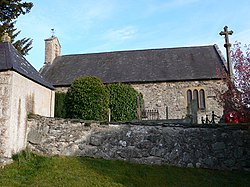Clocaenog: Difference between revisions
Created page with "{{Infobox town |name=Clocaenog |county=Denbighshire |picture=Clocaenog Church - geograph.org.uk - 390043.jpg |picture caption=Clocaenog Church |os grid ref=SJ05SE68 |latitude=..." |
m →Church of St Foddhyd (Meddvyth): clean up, replaced: medieval → mediæval (2) |
||
| Line 18: | Line 18: | ||
==Church of St Foddhyd (Meddvyth)== | ==Church of St Foddhyd (Meddvyth)== | ||
This neat and well-kept church stands on a hill – ‘Clocaenog’ means ‘mossy knoll’ – above the village. Dedicated to St Foddhyd (Meddvyth), ancient records show that its patron was ‘St Meddvyth the Virgin’, daughter of St. Idloes of [[Llanidloes]] in [[Montgomeryshire]]. The restored interior is dominated by a fine ‘rood screen’ (see [[Derwen]]), its top rail intricately carved with trailing foliage and its lower panels with ‘candle-flame’ motifs. These date to about 1538, the date once inscribed in the big east window above the altar. The window now displays fragments of its original stained glass, including heads of men and angels and (in the topmost left-hand light) the nail-pierced feet of a crucified Christ. The roof is also late | This neat and well-kept church stands on a hill – ‘Clocaenog’ means ‘mossy knoll’ – above the village. Dedicated to St Foddhyd (Meddvyth), ancient records show that its patron was ‘St Meddvyth the Virgin’, daughter of St. Idloes of [[Llanidloes]] in [[Montgomeryshire]]. The restored interior is dominated by a fine ‘rood screen’ (see [[Derwen]]), its top rail intricately carved with trailing foliage and its lower panels with ‘candle-flame’ motifs. These date to about 1538, the date once inscribed in the big east window above the altar. The window now displays fragments of its original stained glass, including heads of men and angels and (in the topmost left-hand light) the nail-pierced feet of a crucified Christ. The roof is also late mediæval, as may be the massive dug-out chest hewn from a single tree trunk. Later treasures include the pulpit of 1695 and an elaborate wooden chandelier with beast-head decoration, dated 1725.<ref>{{cite book |title=Enjoy Medieval Denbighshire |author=Dr Charles Kightly |publisher=Denbighshire County Council }}</ref> | ||
==Listed buildings nearby== | ==Listed buildings nearby== | ||
Latest revision as of 10:25, 30 January 2021
| Clocaenog | |
| Denbighshire | |
|---|---|
 Clocaenog Church | |
| Location | |
| Grid reference: | SJ05SE68 |
| Location: | 53°4’31"N, 3°22’14"W |
| Data | |
| Population: | 248 (2001) |
| Post town: | Ruthin |
| Postcode: | LL15 |
| Dialling code: | 01824 |
| Local Government | |
| Council: | Denbighshire |
| Parliamentary constituency: |
Clwyd West |
Clocaenog is a village and parish in Denbighshire on the outskirts of Ruthin. The forest near the village has many walks of varying length and is one of the venues for the Rally of Great Britain.
Church of St Foddhyd (Meddvyth)
This neat and well-kept church stands on a hill – ‘Clocaenog’ means ‘mossy knoll’ – above the village. Dedicated to St Foddhyd (Meddvyth), ancient records show that its patron was ‘St Meddvyth the Virgin’, daughter of St. Idloes of Llanidloes in Montgomeryshire. The restored interior is dominated by a fine ‘rood screen’ (see Derwen), its top rail intricately carved with trailing foliage and its lower panels with ‘candle-flame’ motifs. These date to about 1538, the date once inscribed in the big east window above the altar. The window now displays fragments of its original stained glass, including heads of men and angels and (in the topmost left-hand light) the nail-pierced feet of a crucified Christ. The roof is also late mediæval, as may be the massive dug-out chest hewn from a single tree trunk. Later treasures include the pulpit of 1695 and an elaborate wooden chandelier with beast-head decoration, dated 1725.[1]
Listed buildings nearby
- Grade II*
- Maes Caenog: Farm Building at Plas Clocaenog[2]
- Grade II
- Hen Blas, Plas Clocaenog Farmhouse with attached outbuildings, Sundial in Churchyard, Triple Stable at Plas Clocaenog, Ty Isa, Maes, Tyn-y-mynydd, Kitchen Garden at Pool Park including Former Gardeners' Bothy and War Memorial in St Foddhyd's Churchyard.
References
- ↑ Dr Charles Kightly. Enjoy Medieval Denbighshire. Denbighshire County Council.
- ↑ British Listed Buildings website; accessed 9 May 2014
This Denbighshire article is a stub: help to improve Wikishire by building it up.